Sensitivity of Subjective Decisions in the GLUE Methodology for Quantifying the Uncertainty in the Flood Inundation Map for Seymour Reach in Indiana, USA
Abstract
:1. Introduction

2. Study Area and Data

3. Methodology
3.1. Selection of Prior pdfs and Random Number Generation
| Combination | Case 1 | Case 2 | Case 3 | Case 4 | Case 5 | Case 6 | Case 7 | Case 8 |
|---|---|---|---|---|---|---|---|---|
| TNQNNN | TNQNNU | TNQUNN | TNQAUNU | TUQNNN | TUQNNU | TUQUNN | TUQUNU |
| Initial (Variables) | Model variables updated by random variable (RV) | RV | |
|---|---|---|---|
| Lower | Upper | ||
| Ni, Manning’s n | N = Ni (1 + RV) | −0.375 | 0.375 |
| Qi, Discharge | Q = Qi *1000286RV (m3/s) | −1.963 | 1.963 |
| Ti, Topography | T = Ti + RV (m) | −0.69 | 0.69 |
3.2. Monte Carlo Simulations
3.3. Subjectivities in the GLUE Processes




3.4. Uncertainty Quantification
4. Results
4.1. Monte Carlo Simulations
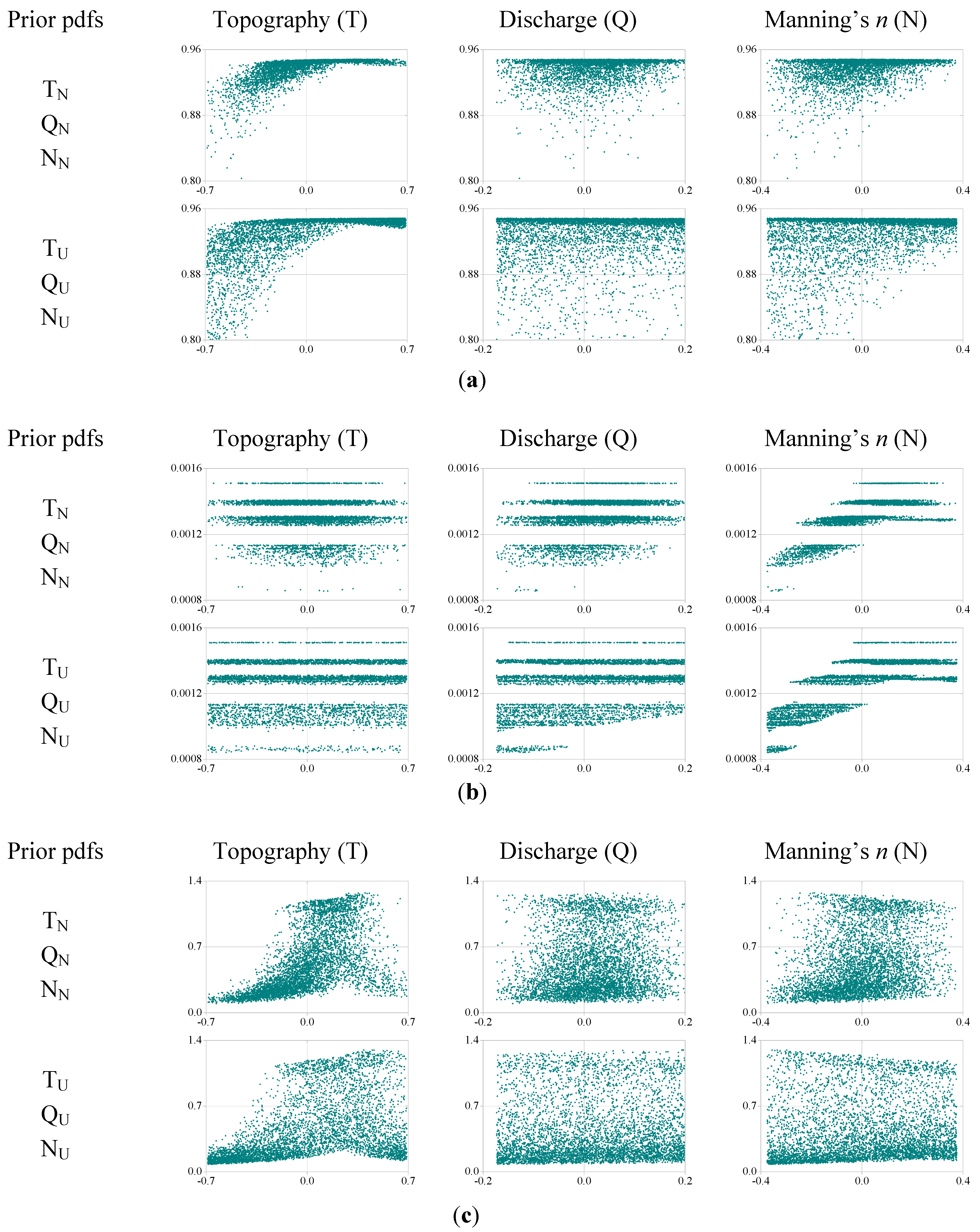
4.2. Effect of Likelihood Measures, Prior/Posterior pdf and Thresholds on GLUE
| LM | Case | 1 | 2 | 3 | 4 | 5 | 6 | 7 | 8 | AVG | SD | |
|---|---|---|---|---|---|---|---|---|---|---|---|---|
| UB | ||||||||||||
| F | Lower 5% | 9.83 | 9.72 | 9.82 | 9.66 | 9.46 | 9.36 | 9.45 | 9.29 | 9.57 | 0.21 | |
| Upper 95% | 10.89 | 10.92 | 10.90 | 10.92 | 10.95 | 10.98 | 10.96 | 10.98 | 10.94 | 0.04 | ||
| Bound | 1.06 | 1.20 | 1.08 | 1.26 | 1.49 | 1.62 | 1.52 | 1.69 | 1.36 | 0.25 | ||
| E | Lower 5% | 10.32 | 10.27 | 10.31 | 10.25 | 10.16 | 10.14 | 10.14 | 10.13 | 10.21 | 0.08 | |
| Upper 95% | 10.8z7 | 10.88 | 10.87 | 10.89 | 10.92 | 10.92 | 10.92 | 10.92 | 10.90 | 0.02 | ||
| Bound | 0.55 | 0.61 | 0.56 | 0.64 | 0.76 | 0.78 | 0.78 | 0.79 | 0.68 | 0.10 | ||
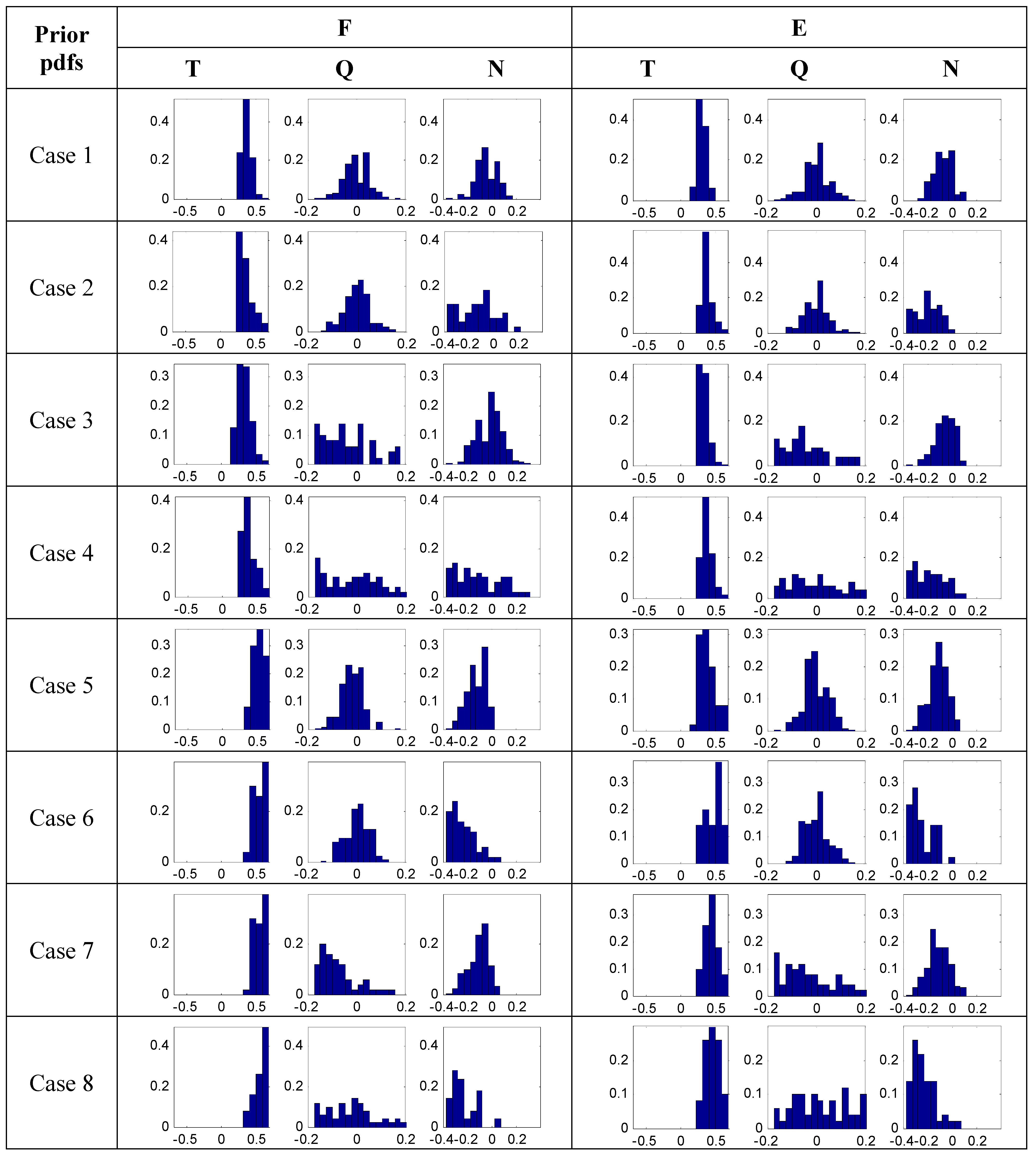
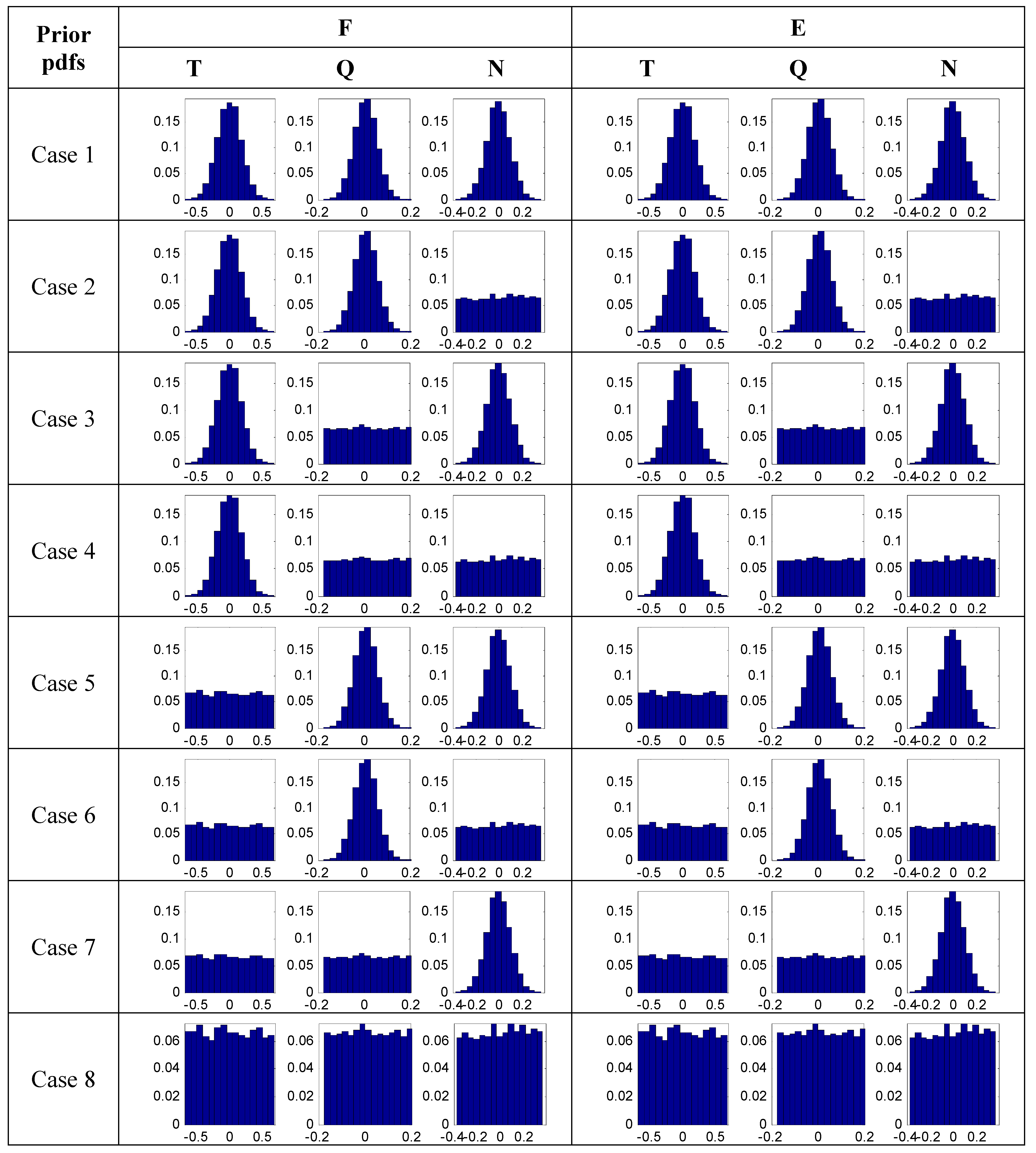
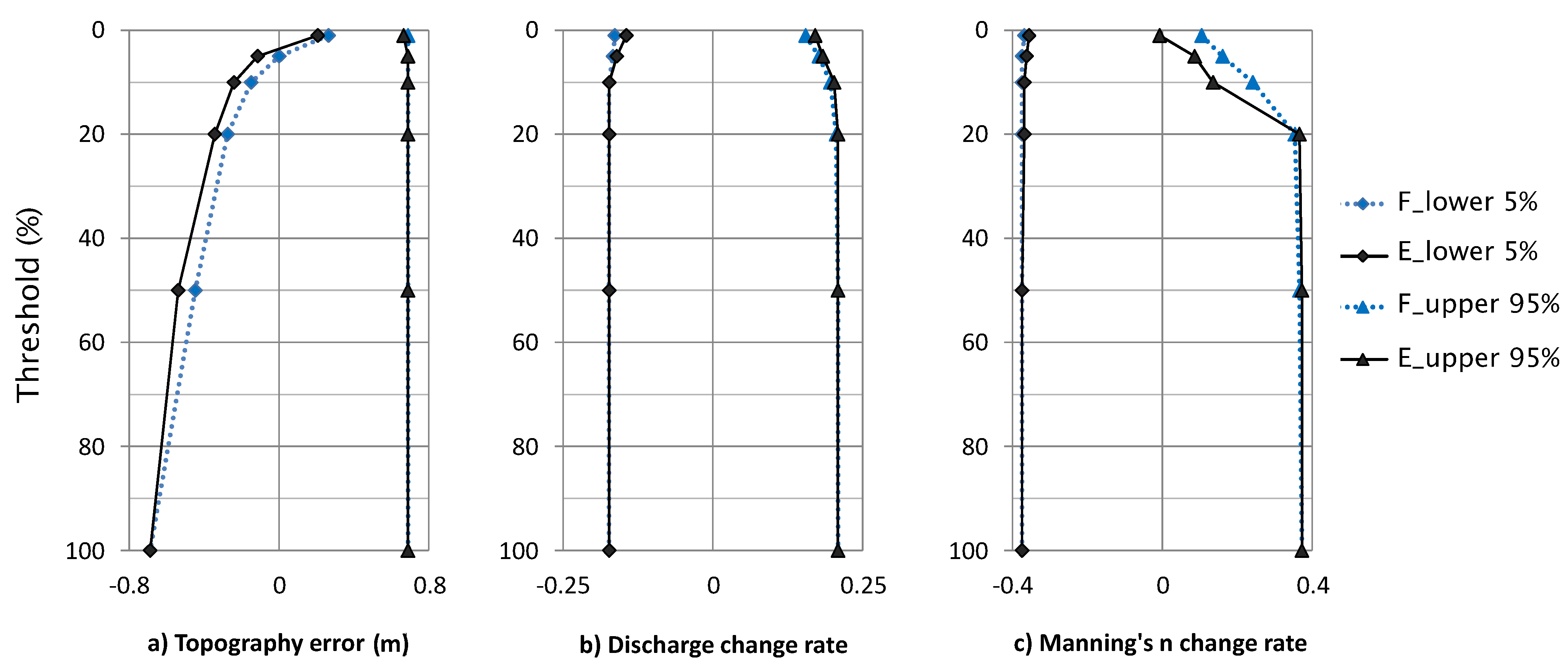
4.3. Uncertainty Quantification
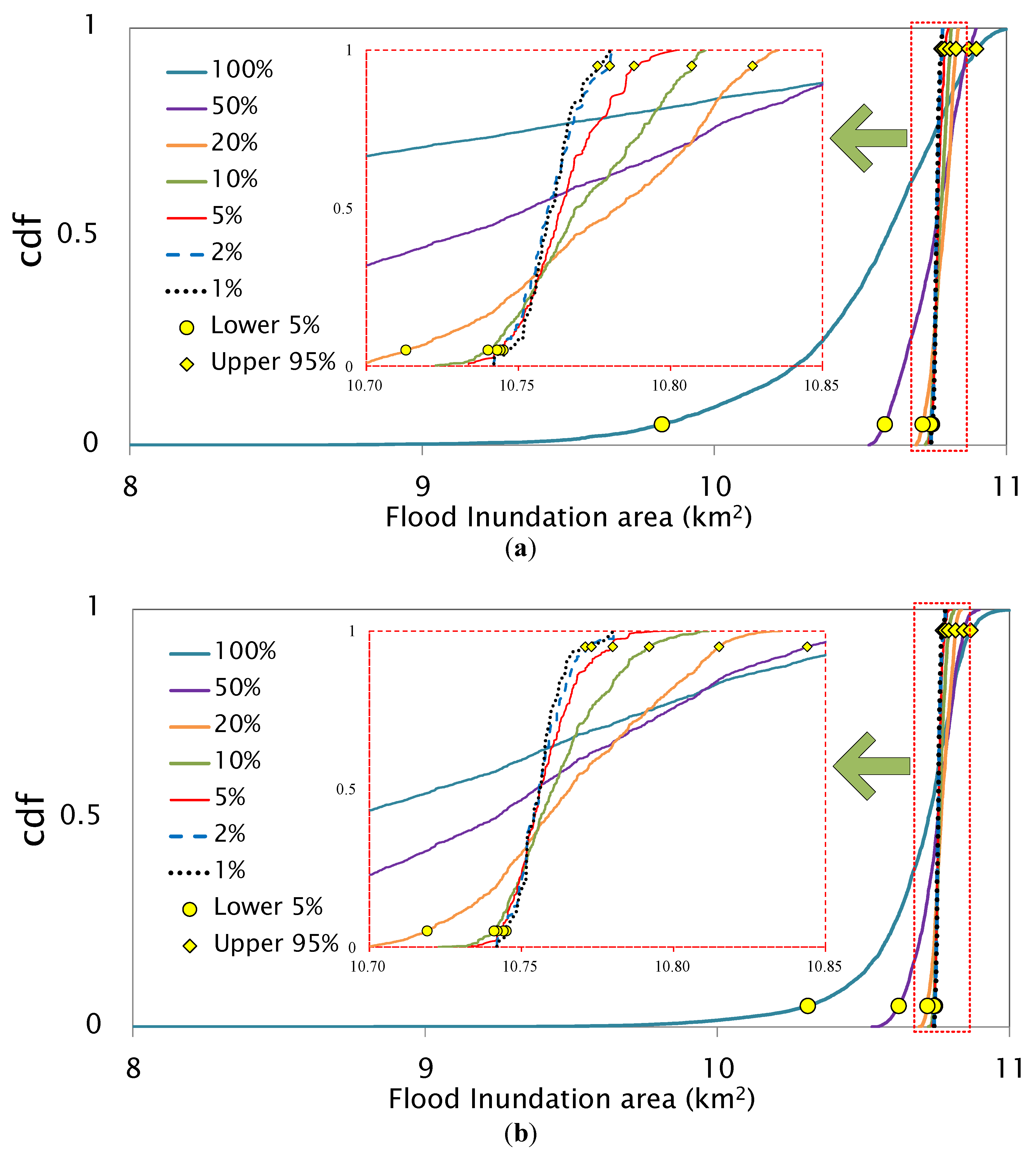
| Threshold (%) | F Likelihood Measure | No. of Accepted Dataset | 5% Lower Bound (L) (km2) | 95% Upper Bound (U) (km2) | Uncertainty Bound (U–L) (km2) |
|---|---|---|---|---|---|
| 1 | 0.9479 | 50 | 10.745 | 10.776 | 0.031 |
| 2 | 0.9478 | 100 | 10.744 | 10.780 | 0.036 |
| 5 | 0.9476 | 250 | 10.743 | 10.788 | 0.045 |
| 10 | 0.9473 | 500 | 10.740 | 10.807 | 0.067 |
| 20 | 0.9468 | 1000 | 10.713 | 10.827 | 0.114 |
| 50 | 0.9444 | 2500 | 10.584 | 10.871 | 0.287 |
| 100 | 0.7499 | 5000 | 9.821 | 10.897 | 1.076 |
| Threshold(%) | E Likelihood Measure (km−1) | No. of Accepted Dataset | 5% Lower Bound (L) (km2) | 95% Upper Bound (U) (km2) | Uncertainty Bound (U–L) (km2) |
|---|---|---|---|---|---|
| 1 | 1.215 | 50 | 10.745 | 10.771 | 0.026 |
| 2 | 1.196 | 100 | 10.744 | 10.773 | 0.029 |
| 5 | 1.156 | 250 | 10.742 | 10.780 | 0.038 |
| 10 | 1.095 | 500 | 10.741 | 10.792 | 0.051 |
| 20 | 0.879 | 1000 | 10.719 | 10.815 | 0.096 |
| 50 | 0.41 | 2500 | 10.621 | 10.844 | 0.286 |
| 100 | 0.093 | 5000 | 10.310 | 10.867 | 0.557 |
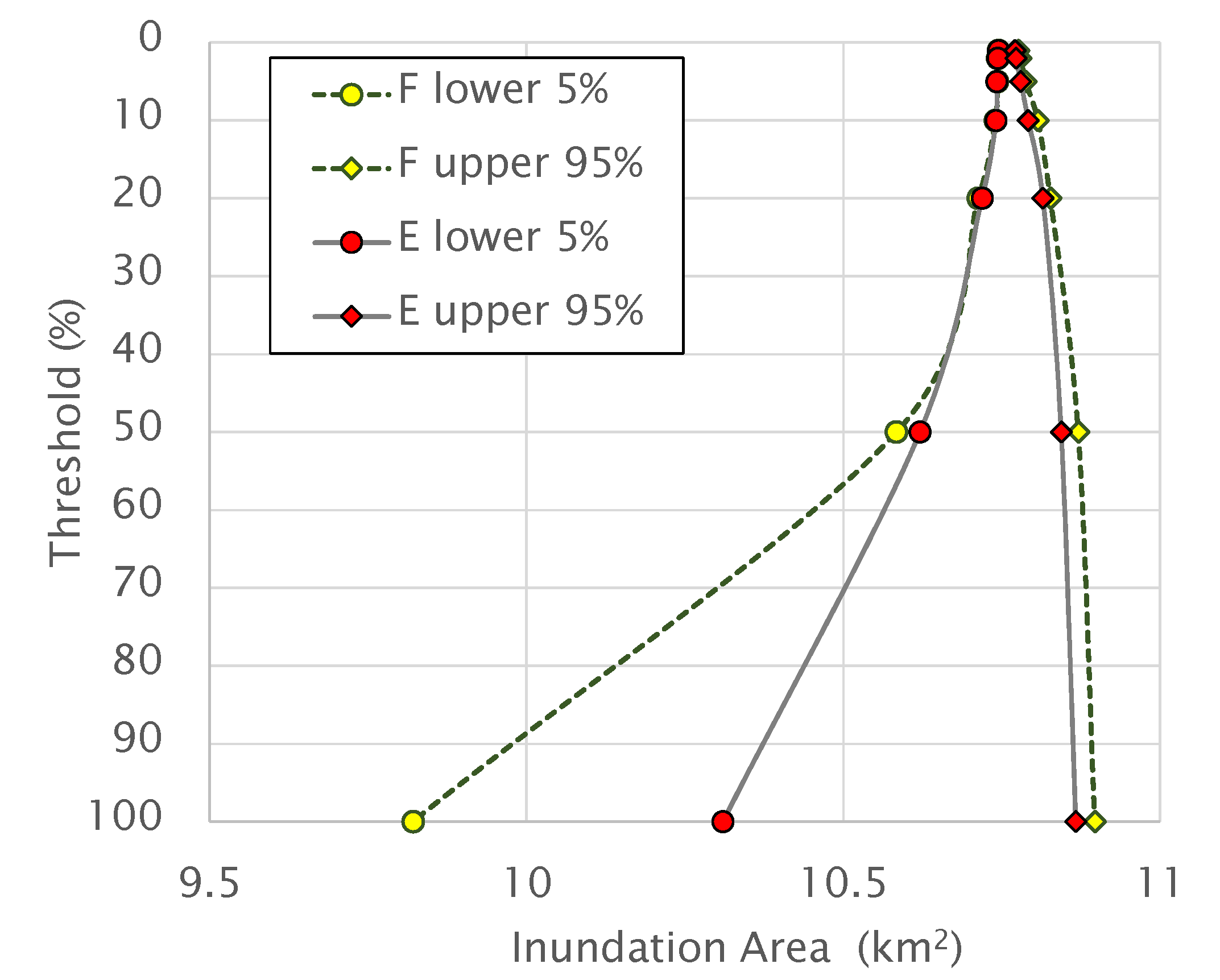
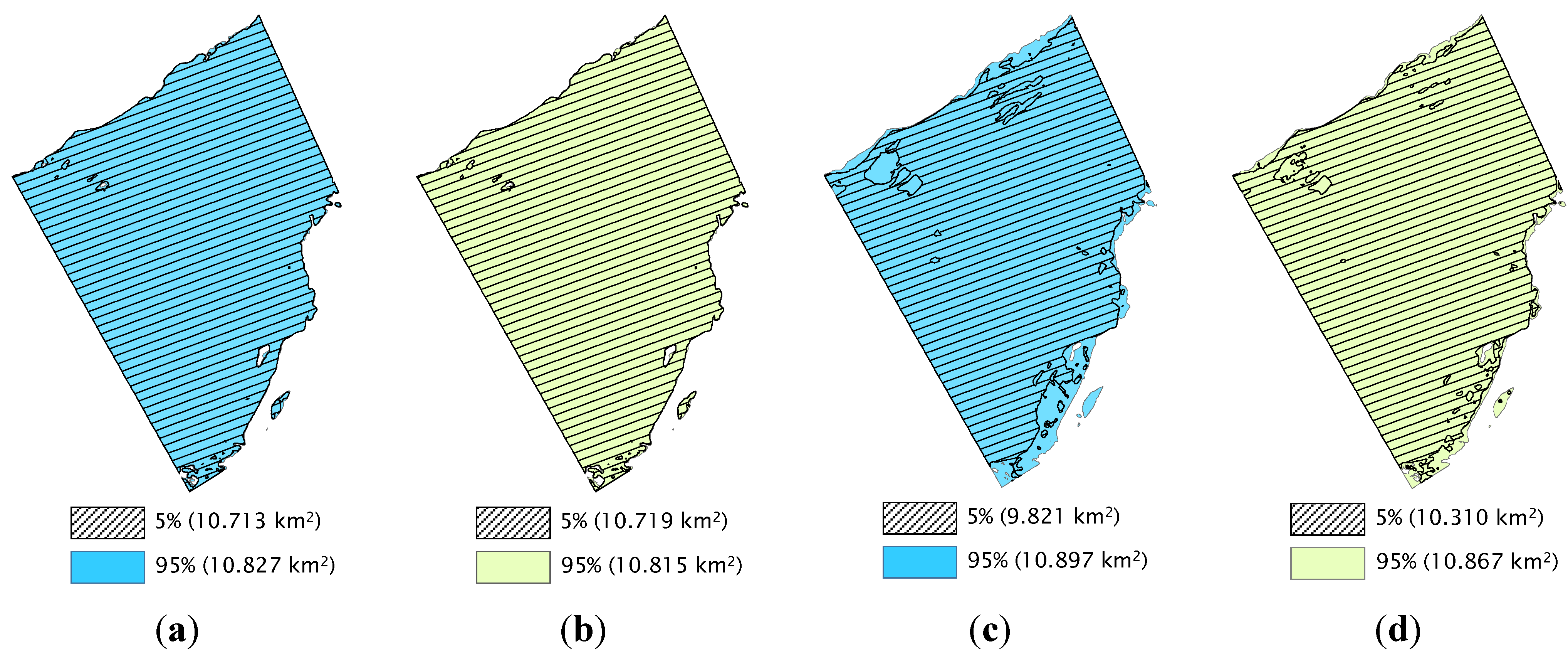
5. Discussion
6. Conclusions
- Results from this study show that the uncertainty bound in GLUE is affected by the type of prior pdf, and that the use of a normal prior pdf for a model variable produces a narrower uncertainty bound compared to a uniform prior pdf.
- Among the three likelihood measures used in this study, the E likelihood measure (Equation (3)) based on water surface elevations is found to be less affected by the combination of prior pdfs for the model variables.
- As the threshold for defining the behavioral model increases to include more datasets, the range of values for a model variable increases in the posterior pdf. This change is more prominent in topography and Manning’s n; whereas discharge does not show much change in the range of values for different cut-off thresholds and likelihood measures.
- The shape of the posterior pdf also changes as the cut-off threshold is changed for different likelihood measures. Usually, the number of datasets used to create an uncertainty bound decreases with tighter thresholds. In order to get a reasonable number of datasets with a tighter threshold for the smooth cdf weighted by behavioral models, a large number of simulations are needed. However, too many simulations can increase the computational burden. Therefore, the number of simulations should be determined by considering the degree of a threshold.
- Although the findings from this study are limited due to the use of a single test case, this paper provides a framework that can be utilized to gain a better understanding of the uncertainty while applying the GLUE methodology in flood inundation mapping. In addition, the application of this framework for other study areas may provide some guidance to generalize the findings of this study, thus advancing this important topic in flood inundation mapping.
Acknowledgments
Author Contributions
Conflicts of Interest
References
- Krzysztofowicz, R. Probabilistic flood forecast: Bounds and approximations. J. Hydrol. 2002, 268, 41–55. [Google Scholar] [CrossRef]
- Beven, K.J.; Binley, A.M. The future of distributed models: Model calibration and uncertainty prediction. Hydrol. Process. 1992, 6, 279–298. [Google Scholar] [CrossRef]
- Liu, Y.B.; Batelaan, O.; De Smedt, F.; Poórová, J.; Velcická, L. Automated Calibration Applied to a GIS Based Flood Simulation Model Using PEST. In Floods, from Defence to Management, Proceedings of the 3rd International Symposium on Flood Defence, Nijmegen, The Netherlands, 25–27 May 2005; Van Alphen, J., van Beek, E., Taal, M., Eds.; CRC Press: Boca Raton, FL, USA, 16 February 2006. [Google Scholar]
- Maskey, S.; Guinot, V.; Price, R.K. Treatment of precipitation uncertainty in rainfall-runoff modelling: A fuzzy set approach. Adv. Water Resour. 2004, 27, 889–898. [Google Scholar] [CrossRef]
- Montanari, A.; Brath, A. A stochastic approach for assessing the uncertainty of rainfall-runoff simulations. Water Resour. Res. 2004, 40. [Google Scholar] [CrossRef]
- Vrugt, J.A.; Diks, C.G.H.; Gupta, H.V.; Bouten, W.; Verstraten, J.M. Improved treatment of uncertainty in hydrologic modeling: Combining the strengths of global optimization and data assimilation. Water Resour. Res. 2005, 41. [Google Scholar] [CrossRef]
- Moradkhani, H.K.L.; Hsu, H.; Gupta, S. Sorooshian Uncertainty assessment of hydrologic model states and parameters: Sequential data assimilation using the particle filter. Water Resour. Res. 2005, 41. [Google Scholar] [CrossRef]
- Aronica, G.; Nasello, C.; Tucciarelli, T. 2D multilevel model for flood wave propagation in flood-affected areas. J. Water Resour. Plan. Manag. 1998, 124, 210–217. [Google Scholar] [CrossRef]
- Romanowicz, R.; Beven, K.J. Dynamic real-time prediction of flood inundation probabilities. Hydrol. Sci. J. 1998, 43, 181–196. [Google Scholar] [CrossRef]
- Romanowicz, R.J.; Beven, K.J. Estimation of flood inundation probabilities as conditioned on event inundation maps. Water Resour. Res. 2003, 39. [Google Scholar] [CrossRef]
- Pappenberger, F.; Beven, K.J.; Hunter, N.; Gouweleeuw, B.; Bates, P.; de Roo, A.; Thielen, J. Cascading model uncertainty from medium range weather forecasts (10 days) through a rainfall-runoff model to flood inundation predictions within the European Flood Forecasting System (EFFS). Hydrol. Earth Syst. Sci. 2005, 9, 381–393. [Google Scholar] [CrossRef]
- Pappenberger, F.; Beven, K.J.; Frodsham, K.; Romanovicz, R.; Matgen, P. Grasping the unavoidable subjectivity in calibration of flood inundation models: A vulnerability weighted approach. J. Hydrol. 2007, 333, 275–287. [Google Scholar] [CrossRef]
- Romanowicz, R.; Beven, K.J.; Tawn, J. Bayesian Calibration of Flood Inundation Models. In Floodplain Processes; Anderson, M.G., Walling, D.E., Bates, P.D., Eds.; Wiley: Chichester, UK, 1996; pp. 333–360. [Google Scholar]
- Heidari, A.; Saghafian, B.; Maknoon, R. Assessment of flood forecasting lead time based on generalized likelihood uncertainty estimation approach. Stoch. Environ. Res. Risk Assess. 2006, 20, 363–380. [Google Scholar] [CrossRef]
- Horritt, M.S. A methodology for the validation of uncertain flood inundation models. J. Hydrol. 2006, 326, 153–165. [Google Scholar] [CrossRef]
- Hunter, N.M. Utility of different data types for calibrating flood inundation models within a GLUE framework. Hydrol. Earth Syst. Sci. 2005, 9, 412–430. [Google Scholar] [CrossRef]
- Mantovan, P.; Todini, E. Hydrological forecasting uncertainty assessment: Incoherence of the GLUE methodology. J. Hydrol. 2006, 330, 368–381. [Google Scholar] [CrossRef]
- Mantovan, P.; Todini, E.; Martina, M. Reply to comment by Keith Beven, Paul Smith and JimFreer on “Hydrological forecasting uncertainty assessment: Incoherence of the GLUE methodology”. J. Hydrol. 2007, 338, 319–324. [Google Scholar] [CrossRef]
- Todini, E.P. Comment on: “On undermining the science?” by Keith Beven. Hydrol. Process. 2007a, 21, 1633–1638. [Google Scholar] [CrossRef]
- Todini, E.P. Hydrological catchment modelling: Past, present and future. Hydrol. Earth Syst. Sci. 2007b, 11, 468–482. [Google Scholar] [CrossRef]
- Todini, E.; Mantovan, P. Hydrological catchment modelling: Past, present and future. Hydrol. Earth Syst. Sci. 2007, 11, 468–482. [Google Scholar] [CrossRef]
- Beven, K.J.; Smith, P.J.; Freer, J.E. Comment on “Hydrological forecasting uncertainty assessment: Incoherence of the GLUE methodology” by Pietro Mantovan and Ezio Todini. J. Hydrol. 2007, 338, 315–318. [Google Scholar] [CrossRef]
- Beven, K.J.; Smith, P.J.; Freer, J.E. So just why would a modeller choose to be incoherent? J. Hydrol. 2008, 354, 15–32. [Google Scholar] [CrossRef]
- Beven, K.J. Environmental Modelling: An Uncertain Future? Routledge: London, UK, 2009; p. 310. [Google Scholar]
- Vrugt, J.A.; Robinson, B.A. Treatment of uncertainty using ensemble methods: Comparison of sequential data assimilation and Bayesian model averaging. Water Resour. Res. 2007, 43. [Google Scholar] [CrossRef]
- Sorooshian, S. Parameter estimation of rainfall run-off models with heteroscedastic streamflow errors—noninformative data case. J. Hydrol. 1981, 52, 127–138. [Google Scholar] [CrossRef]
- McMillan, H.; Clark, M. Rainfall-runoff model calibration using informal likelihood measures within a Markov chain Monte Carlo sampling scheme. Water Resour. Res. 2009, 45. [Google Scholar] [CrossRef]
- Robert, C.; Casella, G. Monte Carlo Statistical Methods, 2nd ed.; Springer: New York, NY, USA, 2004. [Google Scholar]
- Vazquez, R.F.; Feyen, L.; Feyen, J.; Refsgaard, J.C. Effect of grid size on effective parameters and model performance of the MIKE-SHE code. Hydrol. Process. 2002, 16, 355–372. [Google Scholar] [CrossRef]
- Bates, P.D.; Marks, K.J.; Horritt, M.S. Optimal use of high-resolution topographic data in flood inundation models. Hydrol. Process. 2003, 17, 537–557. [Google Scholar] [CrossRef]
- Parodi, U.; Ferraris, L. Influence of stage discharge relationships on the annual maximum discharge statistics. Nat. Hazards 2004, 31, 603–611. [Google Scholar] [CrossRef]
- Merwade, V.M.; Olivera, F.; Arabi, M.; Edleman, S. Uncertainty in flood inundation mapping—Current issues and future directions. J. Hydrol. Eng. 2008a, 13, 608–620. [Google Scholar]
- Kenward, T.; Lettenmaier, D.; Wood, E.F.; Fielding, E. Effects of digital elevation model accuracy on hydrologic predictions. Remote Sens. Environ. 2000, 74, 432–444. [Google Scholar] [CrossRef]
- Vaze, J.; Teng, J.; Spencer, G. Impact of DEM accuracy and resolution on topographic indices. Environ. Model. Softw. 2010, 25, 1086–1098. [Google Scholar] [CrossRef]
- Herschy, R.W. Streamflow Measurement; Elsevier: London, UK, 1985. [Google Scholar]
- Montgomery, D.C.; Peck, A.P.; Vining, G.G. Introduction to Linear Regression Analysis; Wiley: New York, NY, USA, 2001. [Google Scholar]
- Chow, V.T. Open-Channel Hydraulics; McGraw- Hill Book Co.: New York, NY, USA, 1959; p. 80. [Google Scholar]
- Arcement, G.J.; chneider, V.R. Guide for Selecting Manning’s Roughness Coefficients for Natural Channels and Flood Plains US; Geological Survey Water Supply Paper 2339; US Government Printin Office: Washington, DC, USA, 1989; p. 38. [Google Scholar]
- Xiong, L.; O’Connor, K.M. An empirical method to improve the prediction limits of the GLUE methodology in rainfall—Runoff modeling. J. Hydrol. 2008, 349, 115–124. [Google Scholar] [CrossRef]
- Cook, A.; Merwade, V. Effect of topographic data, geometric configuration and modeling approach on flood inundation mapping. J. Hydrol. 2009, 377, 131–142. [Google Scholar] [CrossRef]
- Watson, D.F.; Phillip, G.M. Triangle based interpolation. Math. Geol. 1984, 8, 779–795. [Google Scholar] [CrossRef]
- Beven, K.J. A manifesto for the equifinality thesis. J. Hydrol. 2006, 320, 18–36. [Google Scholar] [CrossRef]
- Beven, K.J. On doing better hydrological science. Hydrol. Process. 2008, 22, 3549–3553. [Google Scholar] [CrossRef]
- Freer, J.; Beven, K.; Ambroise, B. Bayesian estimation of uncertainty in runoff prediction and the value of data: An application of the GLUE approach. Water Resour. Res. 1996, 32, 2161–2173. [Google Scholar] [CrossRef]
- Ratto, M.S.; Tarantola, A. Saltelli Sensitivity analysis in model calibration: GSA-GLUE approach. Comput. Phys. Commun. 2001, 136, 212–224. [Google Scholar] [CrossRef]
- Kinner, D.A.; Stallard, R.F. Identifying storm flow pathways in a rainforest catchment using hydrological and geochemical modelling. Hydrol. Process. 2004, 18, 2851–2875. [Google Scholar] [CrossRef]
- Uhlenbrook, S.; Sieber, A. On the value of experimental data to reduce the prediction uncertainty of a process-oriented catchment model. Environ. Model. Softw. 2005, 20, 19–32. [Google Scholar] [CrossRef]
- Aronica, G.; Bates, P.D.; Horritt, M.S. Assessing the uncertainty in distributed model predictions using observed binary pattern information within GLUE. Hydrol. Process. 2002, 16, 2001–2016. [Google Scholar] [CrossRef]
- Horritt, M.S.; Bates, P.D. Effects of spatial resolution on a raster based model of flood flow. J. Hydrol. 2001, 253, 239–249. [Google Scholar] [CrossRef]
- Willmott, C. On the validation of models. Phys. Geogr. 1981, 2, 184–194. [Google Scholar]
- Willmott, C. Some comments on the evaluation of model performance. Bull. Am. Meterol. Soc. 1982, 63, 1309–1313. [Google Scholar] [CrossRef]
- Pappenberger, F.; Beven, K. Functional classification and evaluation of hydrographs based on multicomponent mapping. Int. J. River Basin Manag. 2004, 2, 1–8. [Google Scholar]
- Blazkova, S.; Beven, K.J. Uncertainty in flood estimation. Struct. Infrastruct. Eng. Maint. manag. Life-Cycle Des. Perform. 2009, 5, 325–332. [Google Scholar] [CrossRef]
- Mason, D.C.; Bates, P.D.; Dall’Amico, J.T. Calibration of uncertain flood inundation models using remotely sensed water levels. J. Hydrol. 2009, 368, 224–236. [Google Scholar] [CrossRef]
- Jung, Y.; Merwade, V. Uncertainty quantification in flood inundation mapping using generalized likelihood uncertainty estimate and sensitivity analysis. J. Hydrol. Eng. 2012, 17, 507–520. [Google Scholar] [CrossRef]
- Hornberger, G.M.; Beven, K.J.; Cosby, B.J.; Sappington, D.E. Shenandoah watershed study: Calibration of the topography-based, variable contributing area hydrological model to a small forested catchment. Wat. Resour. Res. 1985, 21, 1841–1850. [Google Scholar] [CrossRef]
© 2014 by the authors; licensee MDPI, Basel, Switzerland. This article is an open access article distributed under the terms and conditions of the Creative Commons Attribution license (http://creativecommons.org/licenses/by/3.0/).
Share and Cite
Jung, Y.; Merwade, V.; Kim, S.; Kang, N.; Kim, Y.; Lee, K.; Kim, G.; Kim, H.S. Sensitivity of Subjective Decisions in the GLUE Methodology for Quantifying the Uncertainty in the Flood Inundation Map for Seymour Reach in Indiana, USA. Water 2014, 6, 2104-2126. https://doi.org/10.3390/w6072104
Jung Y, Merwade V, Kim S, Kang N, Kim Y, Lee K, Kim G, Kim HS. Sensitivity of Subjective Decisions in the GLUE Methodology for Quantifying the Uncertainty in the Flood Inundation Map for Seymour Reach in Indiana, USA. Water. 2014; 6(7):2104-2126. https://doi.org/10.3390/w6072104
Chicago/Turabian StyleJung, Younghun, Venkatesh Merwade, Soojun Kim, Narae Kang, Yonsoo Kim, Keonhaeng Lee, Gilho Kim, and Hung Soo Kim. 2014. "Sensitivity of Subjective Decisions in the GLUE Methodology for Quantifying the Uncertainty in the Flood Inundation Map for Seymour Reach in Indiana, USA" Water 6, no. 7: 2104-2126. https://doi.org/10.3390/w6072104
APA StyleJung, Y., Merwade, V., Kim, S., Kang, N., Kim, Y., Lee, K., Kim, G., & Kim, H. S. (2014). Sensitivity of Subjective Decisions in the GLUE Methodology for Quantifying the Uncertainty in the Flood Inundation Map for Seymour Reach in Indiana, USA. Water, 6(7), 2104-2126. https://doi.org/10.3390/w6072104






